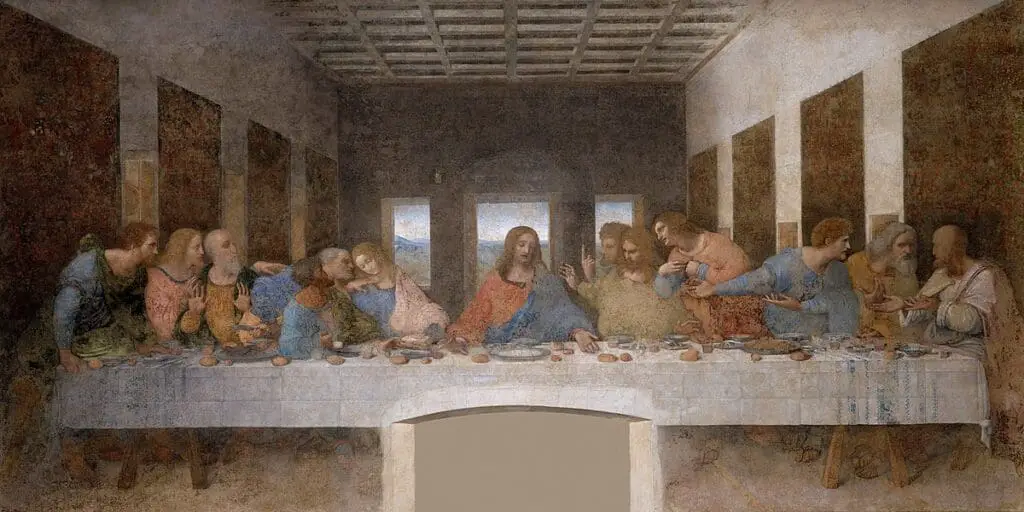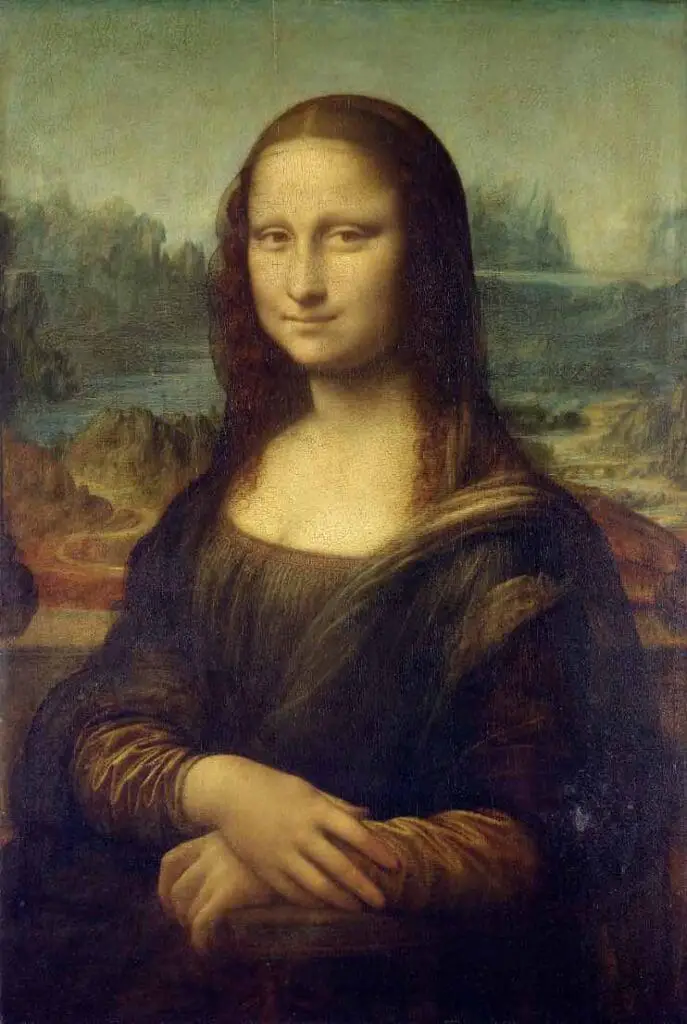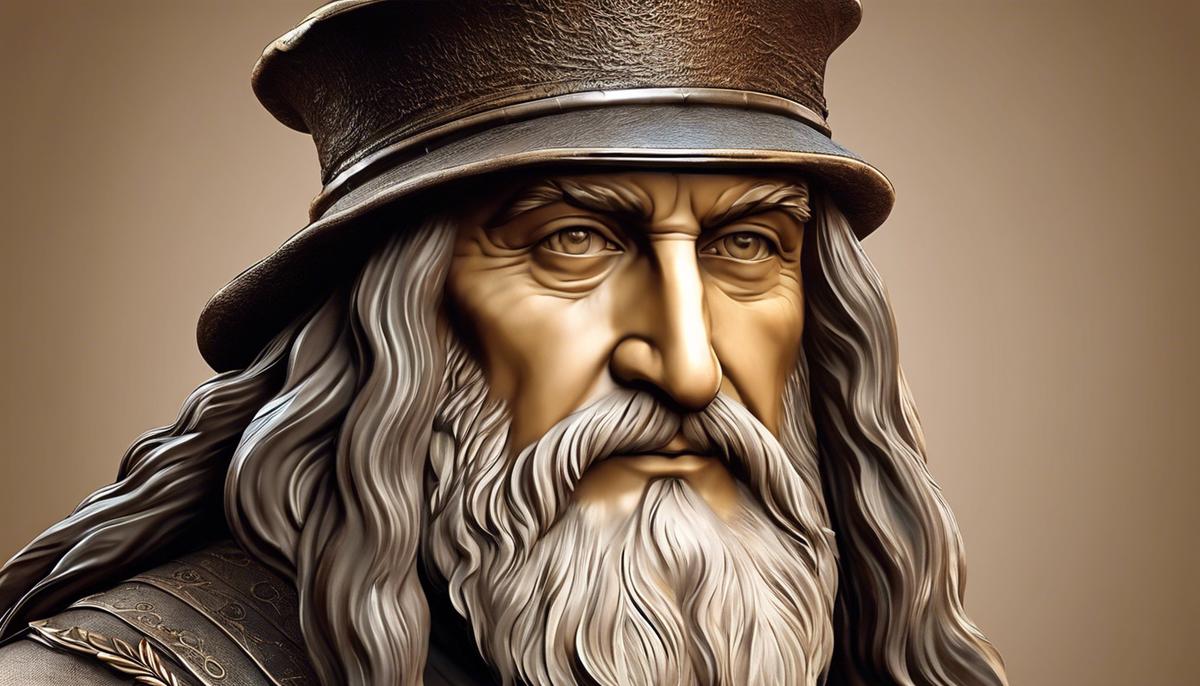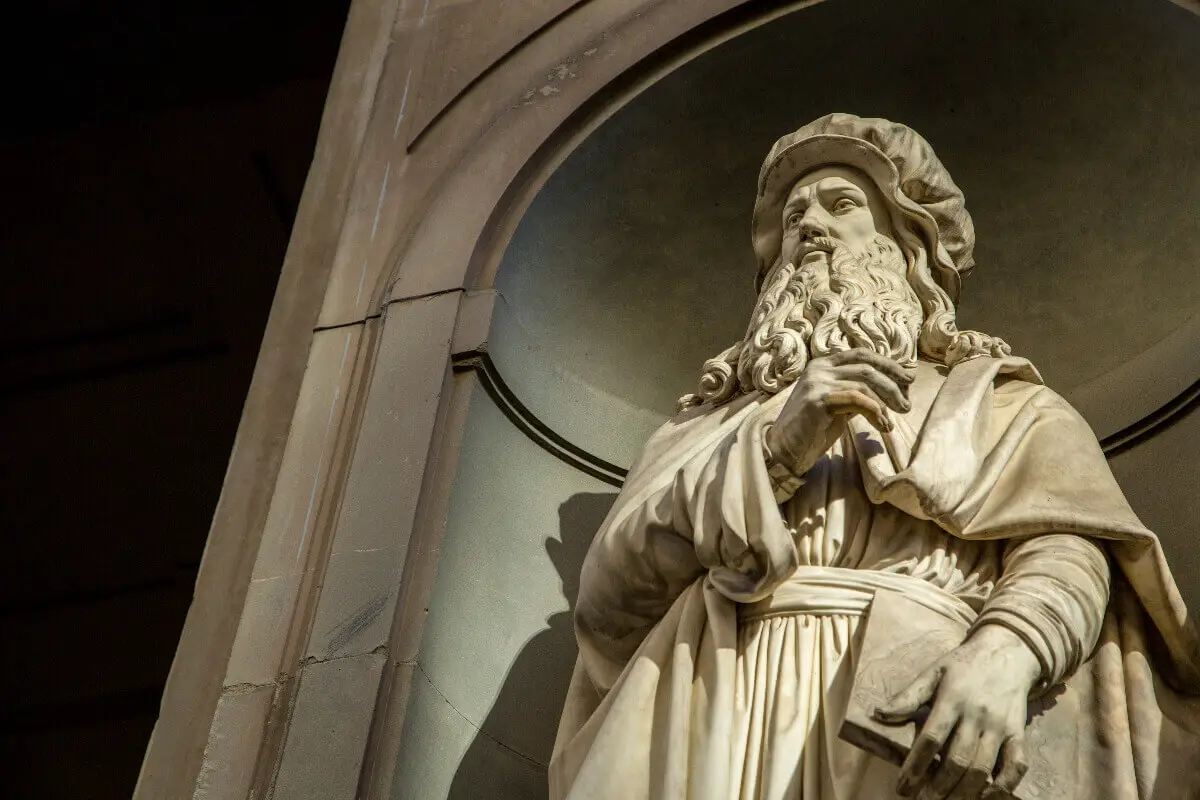Leonardo Da Vinci, a universal genius with a mind steeped in artistic vision and scientific inquiry, is an unparalleled pillar in art and beyond. His formative years, marked by an early exposure to the arts and an apprenticeship under Andrea del Verrocchio, constructed a foundation upon which his astonishing mastery would grow, culminating in the fusion of art and science that he seamlessly achieved.
The exploration of Da Vinci’s genesis provides an understanding of this Renaissance Master’s artistic evolution as it delves into his childhood, his initial encounters with art, and his journey toward achieving the sublime coupling of artistry and scientific inquiry that permeates his works.
Table of Contents
- Genesis of Leonardo Da Vinci’s Art
- Da Vinci’s Mastery: Portraits & Anatomical Works
- Legacy and Influence
- Related Questions
Genesis of Leonardo Da Vinci’s Art
As we delve into the world of art and its innumerable layers, it’s unavoidable not to mention and marvel at Leonardo Da Vinci. His works not only revolutionized the realm of art but also set a precedent that artists have tried to replicate and learn from across centuries. It begs the question: what were the practical and theoretical influences shaped his art to the magnitude it did?
Firstly, Leonardo da Vinci’s art was distinctly influenced by the socio-cultural context of the Renaissance period. The epoch was a period of great intellectual questioning, paradigm shifts, and a blossoming of creativity in art, literature, and science. Artists were free to explore, innovate, and break traditional molds.
Leonardo was greatly intrigued by the application of scientific knowledge to art. His keen interest in the scientific method and relentless curiosity sent him on exploration journeys for knowledge that would later inform his art.
Anatomy, for instance, featured heavily in his work. His scientific study of the human body revealed his sense of meticulousness. For Leonardo, it wasn’t just about the aesthetic appearance of the body but its functionality and operation. His artistic incursions into anatomical studies fundamentally shifted the representation of the human figure in Western art.

Alongside this, Da Vinci was profoundly influenced by theoretical ideas of perspective. His innovative use of linear perspective led to greater realism in his art. He achieved this in a masterpiece like “The Last Supper,” where linear perspective creates a sense of depth, guiding the viewer’s eye to the center of the action.
Similarly, another theoretical factor was Leonardo’s preoccupation with ‘sfumato’—a technique used to blur or veil contours and soften the transition between colors and tones to create perceptions of depth, volume, and form.

In “Mona Lisa,” this technique can be observed around the corners of her mouth and eyes, contributing to her famously enigmatic expression.
It is also worth mentioning that Leonardo’s training under Andrea del Verrocchio during his early life laid the practical foundation for his blossoming artistic prowess. Verrocchio’s meticulous nature, emphasis on order and clarity, and Florentine drafting technique can be traced in Leonardo’s early works.
Leonardo’s art was shaped practically by his voracious study, observation, and exhaustive sketching of the world. This approach went in symphony with the theoretical lessons he imbibed from the artistic tradition of Renaissance Italy, especially the emerging scientific perspective and empirical understanding of the world.
Whether it was his detailed studies of human anatomy or his constant exploration of the natural world, Leonardo da Vinci transformed the world of art by blending his insatiable curiosity with a boundless creativity that left an indelible mark on human culture.
His unique ability to intertwine science and art, the logical with the creative, set the stage for future artists to push boundaries and break free from the traditional norms, redefining the conventional notions of art.

Da Vinci’s Mastery: Portraits & Anatomical Works
Underlying Leonardo da Vinci’s artistic success were the proactive steps he took to ensure the quality and precision of his work. His relentless pursuit of excellence made him one of art history’s most renowned and influential artists.
Da Vinci was a true embodiment of the ‘Renaissance Man’ — a polymath whose areas of interest extended beyond painting to include anatomy, sculpture, architecture, and even science and mathematics.
Leonardo’s portraits stood out for their unrivaled realism, which can be significantly attributed to his profound understanding and utilization of anatomical accuracy.
Not merely satisfied with the superficial anatomy comprehension customary of artists of his era, Leonardo vestigially ventured into dissecting human and animal bodies, making numerous sketches of muscles, tendons, and other visible physical features.
His working library included copious notebooks filled with startlingly precise and intricate drawings of human organs, including the heart and vascular system. Da Vinci’s fixation on accuracy even led him to inquire about how the aortic valve opens and closes.

Leonardo’s anatomical studies and scientific approach are conspicuous in portraits such as La Bella Principessa and Mona Lisa. The sublime portrayal of the human form derived from this innovative approach resulted in figures so lifelike that they appear as though they could step off the canvas and into our world.
Each figure is a product of meticulous observation of human emotion, conveyed through delicate variations in facial expression, achieved by his skillful hand and acute attention to minute details.
Leonardo’s anatomical accuracy is closely tied to his masterful use of chiaroscuro, wherein he employed varying shades of light and darkness to model three-dimensional figures and faces.
This technique was used to exceptional effect when rendering the contours of the human body, exploiting the analytical understanding he possessed of the play of light and shadow on different forms and surfaces.
Through this relentless exploration of anatomical detail, Leonardo presented an entirely revolutionary perspective to portrait painting that was groundbreaking for his time and continued to resonate even in the centuries beyond.
His applications of these scientific principles, all aimed at recreating an exact visual representation of the reality he observed, set him apart and placed him ahead of his contemporaries.
Even as Leonardo stood as a brilliant embodiment of the fusion of science and art, his influence on art was enormous, contributing significantly to the Renaissance and our understanding of art and science today.
Leonardo da Vinci’s legacy goes beyond the remarkable paintings and sculptures he left behind. Still, it lies in the inventive method and passionate curiosity he followed, which forever changed the world of art. Little wonder, then, that his works continue to be celebrated and revered even in the 21st century.

Legacy and Influence
Beyond the Vitruvian Man’s magnificent strokes and the Mona Lisa’s mysterious smile, Leonardo Da Vinci’s influence permeates the annals of art and the broader scope of visual culture and scientific inquiry.
His innovative approach, multi-faceted interests, and willingness to challenge established norms fundamentally altered the trajectory of art history.
His diligent commitment to excellence and quality was a critical aspect that underscores Leonardo’s influence. Every Leonardo creation was a testament to his tireless pursuit of perfection, from his minute pen-and-ink studies to his grand mural designs.
His unwavering dedication positively influenced his contemporaries and set a new benchmark for future generations of artists.
Moreover, as a true Renaissance man, Leonardo’s interest extended beyond painting and drawing. His notebooks, filled with intricate studies of anatomy, hydraulics, flight mechanisms, and architectural designs, reveal the vast expanse of his interests.
This interdisciplinary approach facilitated a creative cross-pollination between science, art, and technology, opening up new avenues of exploration for future practitioners.
Emphasizing this intersectionality of interests, Leonardo’s paintings often exhibited an uncanny anatomical precision. Works like the Lady with an Ermine, La Bella Principessa, and the Mona Lisa testify to his anatomical studies.
The lifelike manifestation of the underlying bone structure and musculature in his portraits set a new standard for artists and resonated with the scientific community.
His groundbreaking application of the chiaroscuro technique was another significant aspect of his influence. By experimenting with lights and shadows, he breathed life into his subjects.
The enduring impact of this technique can be observed in the works of later artists like Caravaggio and Rembrandt, who further explored and developed the technique to capture and express human emotion vividly.
Leonardo’s influence also stretched to the field of portrait painting. Before him, portraits were often rigid and lifeless. However, Leonardo introduced a revolutionary perspective to the practice.
He sought to capture the physical likeness of the subject and their personality and spirit. This transformative approach forever changed the course of portraiture, influencing the likes of artists like Johannes Vermeer and Diego Velázquez.
The fusion of art and science in Leonardo’s work set a precedent that resonates with the art world. Modern artists drawing from science-tinted glasses, such as Gyula Kosice or Robert Smithson, testify to Leonardo’s enduring influence.
His visionary combination of these disciplines has also spurred debates and exploration at the intersection of art, science, and technology.
In summary, Leonardo Da Vinci’s influence is far-reaching and enduring. It extends beyond the confined boundaries of the canvas into the expansive arena of scientific exploration, architectural design, and technological innovation.
Even in the 21st century, we find ourselves marveling at the genius of Leonardo, demonstrating that his brilliant flame continues to light the path for an array of contemporary artists, scientists, and thinkers. His legacy, thus, remains an integral part of the cultural fabric, eternally interwoven into the tapestry of human creativity and innovation.
Leonardo Da Vinci’s contributions were game-changers, serving as benchmarks and a compass directing the journey of artistry after that. His innovations in painting, drawing, and anatomical studies revolutionized these disciplines and played a pivotal role in shaping the future of art history.
Da Vinci was not merely a product of his time but a visionary whose impact rippled through subsequent artistic movements. He continues to inspire and influence artists even today, proving his timeless relevance.
Thus, it is by truly understanding Da Vinci’s nuanced journey, mastery, and enduring legacy that one can fully appreciate the spectacular brilliance of this luminary artist and the footprint he has left on the sands of time.
Anita Louise Art is dedicated to art education, great artists, and inspiring others to find and create their art. We love art that uplifts and inspires. #ArtToMakeYouSmile! #ArtToMakeYouHappy!
If you are interested to see any of my art, you can find out more by clicking here. If you are interested in what inspires me and my paintings, you can discover more by clicking here.
We have a free newsletter and would love you to be part of our community; you can subscribe to the newsletter by clicking here. I would be happy to talk to you if you have any questions. You can reach me, Anita, by clicking here.
Subscribe to our Anita Louise Art YouTube Channel filled with great videos and information by clicking here.
Join us for our podcast “5 Minutes With Art.” Spend 5 minutes a week with us to discover and learn about great art and artists. You can find out more about our podcast by clicking here.
Related Questions
12 Years Leonardo Painted Mona Lisa’s Lips, Facts Or Fiction?
The Mona Lisa painting is one of the most viewed and recognizable paintings globally. But like any great painting, many facts and fiction surround the painting.
No evidence shows Leonardo da Vinci spent 12 years painting the Mona Lisa smile. Most scholars believe that he painted the painting in 4 years but then had the painting much longer in his possession. He could have worked on it a bit or adjusted it when he had it in his possession, but there is no evidence to show that.
By clicking here, you can learn more by reading 12 Years Leonardo Painted Mona Lisa’s Lips, Facts Or Fiction?
What Inspired Leonardo da Vinci To Paint The Last Supper?
Duke Ludovico Sforza commissioned Leonardo to paint the Last Supper mural. What makes the Last Supper mural so unique is that he painted it at the exact time when Christ told the Apostles during The Last Supper meal that one of them would betray him. Leonardo showed the apostles’ reactions, including Judas, who betrayed Christ.
By clicking here, you can learn more by reading What Inspired Leonardo da Vinci To Paint The Last Supper?
Did Michelangelo And Leonardo Know Each Other?
Michelangelo and Leonardo da Vinci knew each other but were considered bitter rivals. Leonardo da Vinci and Michelangelo knew each other, but they did like each other. They were both asked to do a commission on the Council Hall of the Palazzo Vecchio and were supposed to work side-by-side; the project was never completed.
By clicking here, you can learn more by reading Did Michelangelo And Leonardo Know Each Other?

